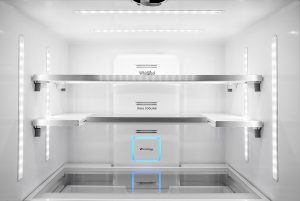1. Check the Obvious Signs
Before you get into any serious troubleshooting, you should check for obvious signs of a problem. Check the thermostat inside the refrigerator has not been accidentally adjusted. This can be easy to do when you’re putting items in or taking items out of the fridge, but even a minor adjustment can impact how cool your refrigerator feels. You should also check that your fridge is still properly plugged into the power supply. Finally, check if anything is blocking the vents and preventing cold air from circulating.
2. Listen to Your Compressor
Once you have determined there is no obvious problem, you need to start your troubleshooting by listening to your appliance. One of the common issues occurs with the compressor. This component pushes vapor into the coils outside the refrigerator. But, if you listen closely you may be able to tell if your compressor is not working properly.
You will need to move the refrigerator away from the wall slightly and have a listen. If the motor is running and producing a slight hum, but the temperature of the refrigerator is above normal, you may have a compressor problem.
3. Inspect Your Condenser Coils
The condenser coils are perhaps the most hardworking component in your refrigerator. They are responsible for taking hot gas and condensing it into a cool liquid to keep your refrigerator cold. When the condenser coils are not operating correctly, it is very difficult for the refrigerator to remain cool.
Unfortunately, condenser coils can be compromised by debris. Since they are usually located at the back or underneath the appliance, they can easily get covered in dust, pet hair, dirt and other debris. Locate the condenser coils on your model of refrigerator and see if they look dirty. If they are clogged, you’ll need to clean them. This will involve emptying and unplugging the appliance and then using a vacuum cleaner attachment to clear away the debris.
4. Test Your Evaporator Fan
Finally, the problem could be related to the evaporator fan. This circulates the cold air through the appliance, so if it stops working, the refrigerator will start to feel warmer. The evaporator fan is behind the freezer wall, so to test if it is operating properly, you will need your refrigerator to go into diagnostic mode.
The process to do this varies between different makes and models, but you’ll find the instructions in your owner’s manual. It will usually involve repeatedly doing something such as flicking the light on and off.
When the refrigerator has gone into diagnostic mode, you’ll need to look at the instructions to run an evaporator fan test. If the fan runs during the test, it is likely a problem with the control board, but if it fails to run, you may need to have the evaporator fan replaced.
Of course, if you are uncomfortable with any aspect of this troubleshooting or are having difficulty determining the underlying problem with your refrigerator, it is time to call in professional assistance. An experienced appliance repair technician has the skills and expertise to deal with all appliance issues and problems. The technician will be able to assess your refrigerator and provide a diagnosis to get your fridge operating correctly again.
